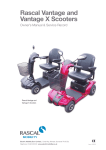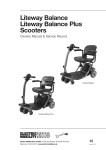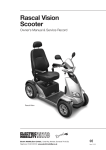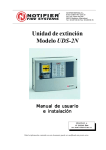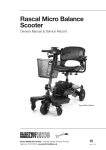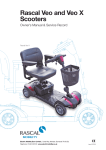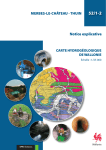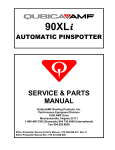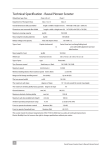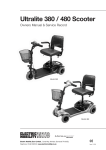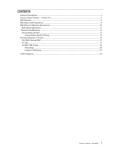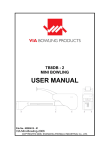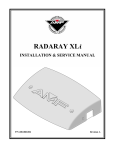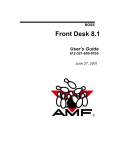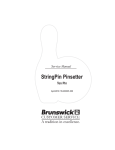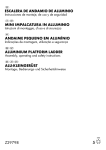Download Spare practice play for an automatic pinspotter
Transcript
June 18, 1963 “SANG Y. WHANG ETAL 3,094,327 SPARE PRACTICE PLAY FOR AN "AUTOMATIC EINSPOTTEER Filed May '6, 1960 6 ‘Sheets-Sheet ‘1 June 18, 1963 "'SANG ‘Y.‘WHANG ETAL 3,094,327 ‘:SPARE PRACTICE ‘PLAY "FOR "AN AUTOMATIC YPINSPOTTER Filed May\6. 1960 ' ’ CGSheets-Sheet '2 41 [I @ 3,9 ' 39a ml 45 $1] 4_'________?;,m, , 44 38 m. i‘; ii‘ _4_ ATTORNEY June 18, I963 _ SANG WHANG ETAL 3,094,327 SPARE PRACTICE PLAY FOR AN AUTOMATIC PINSPOTTER Filed May a, 1960 6 Sheets-Sheet 3 lvau J20 9 T1 :1. 5. 260 ° 00 [O 135" 0 SEC. 2.20’ SEC. A 77445»? Por/rrm/v 6' SEC. INVENTORS SAM/C7‘ K W/m/vs 30/? my 1/. ,S'EIDA/EA’ BY // / ATTORNEY June I8, 19633 SANG Y. WHANG ETAL - - 3,094,327 ' SPARE PRACTICE PLAY FOR AN AUTOMATIC PINSPOTTER Filed May _6. 1960 6 Sheets-Sheet 4 1 ' E. Ta [NERQUPI'Z’R or v ' Z4L/D-C. I BYéAp/M ATTORNEY June 18, 1963 SANG Y. WHANG ETAL 3,094,327 SPARE PRACTICE PLAY FOR AN AUTOMATIC PINSPOTTER Filed May 6, 1960 $5. 6 Sheets-Sheet 6 if.W W/m MMlawA 56D, R / W. ‘mac. United States Patent 0’ a C6 3,094,327 Patented June 18, 1963 1 2 3,094,327 spare practice play the distributor will stop at preselected table cups corresponding to those tenpins constituting the combination desired for spare practice play and wherein SPARE PRACTICE PLAY FOR AN AUTOMATIC PINSPOTTER Sang Y. Whang, 12 Hinsdale St., Bro‘oklyn, N.Y., and Burton V. Seidner, 9 Pinetree Lane, Great River, N.Y. the distributor by-passes all other table cups. It is a further object of the invention to modify a por tion of the electrical system for regulating operation of the current pinspotter apparatus, whereby such apparatus may - 26 Claims. (Cl. 273-43) be used for normal tenpin play or spare practice play whenever desired, and when operated for the latter, said This invention relates to automatic pinspotter apparatus designed to spot ten tenpins on a bowling alley ?oor so 10 modi?ed circuit is devised to regulate the pin elevator cam gate energizing circuit so that the elevator delivers a single that a bowler may play the customary tenpin bowling Filed May 6, 1960, Ser. No. 27,328 tenpin when the distributor is stopped at a selected table cup and wherein the elevator gate circuit is temporarily The well known automatic pinspotter currently in use is de-actuated to prevent delivery of a tenpin after releasing made by American Machine & Foundry Company. This apparatus is adapted to spot automatically ten tenpins on 15 just one ten-pin. Another modi?cation of the electrical system involves the pin counter switch which is actuated a bowling alley ?oor against which a bowler plays his when a ?rst tenpin is released to the distributor and game. Automatic operation of the pinspotter also con counted, and which switch is de-actuated after a pre templates removal of “dead wood” after the ?rst ball is selected number of tenpins constituting the desired set to thrown, at which time the pinspotter is holding the spare wood missed by the ?rst ball. The apparatus automati 20 make up a combination of spare practice pins are counted out. A fourth modi?cation involves the distributor posi cally respots the spare pins for second ball throw. This tion switch circuit such that the circuit opens when the machine also involves other phases of automatic opera ?rst tenpin of the aforesaid desired set is counted and tion, such as spotting a new set of tenpins after a strike which circuit is closed when the distributor head reaches throw. With the growing popularity of bowling as a game, more 25 a position along the track corresponding to the ?rst of the game. persons are ?nding it desirable to practice against one or combinations of two or more tenpins constituting spare “woods” and, in particular, those spare combinaitons of selected table cups at which the distributor started distri bution of the aforesaid given set of pins. Further objects and advantages ‘will become apparent from the following description of the invention taken in spares that prove to be di?icult to the individual bowler. For such spare pratcice, each ‘bowler may wish to practice 30 conjunction with the ?gures, in which: FIG. 1 illustrates in perspective elevation and partly against different combinations of spare wood. At pres cut away an automatic pinspotter currently employed in ent, spare practice can be achieved by having a pin boy numerous ‘bowling alleys; setting up the spare wood. Hence, it would be desirous ‘FIG. 2 is a perspective View of the track means em if the foregoing apparatus, in addition to its normal cycle of operation, is also capable of spotting one or more com 35 ployed in the aforesaid apparatus; FIG. 3 is a fragmentary sectional elevation of the dis binations of spare standing pins against which aperson tributor head showing same in operative engagement with can practice. Consequently, the instant invention con the track means and incorporates an embodiment of struc templates certain modi?cations to the current automatic tural modification to ‘said track in accordance with the pinspotter apparatus, such that, in addition to its normal operation, it will also :be capable of spotting any com 40 improvements claimed herein; bination of one to ten tenpins so that a bowler may prac tice against any desired combination of spare standing FIG. 4 is a fragmentary plan view showing the adjust able stopper attached to said track in accordance with the invention; A wood. The invention is designed so that the machine will FIG. 5 is a sectional view taken along line 5-5 of continue to provide such desired combination of spare tenpins until the machine is actuated to provide a different 45 FIG. 4; FIG. 6 is a fragmentary perspective View showing de combination of spare tenpins or, if desired, the machine tails of the stopper in accordance with the invention; returns to normal operation of spotting ten tenpins on the ‘FIG. 7 is a schematic diagram of the sixth level of the floor for the ‘bowling game. stepper relay circuit currently employed in the aforesaid As a further advantage, of the instant invention, the modi?cations contemplated herein ‘for allowing a machine 50 pinspotter apparatus; FIG. 8 is a schematic view of cam pro?les currently to provide spare play practice involves certain structural and electrical changes to the pinspotter which maybe readily incorporated into the standard American Machine employed in the pinspotter electrical circuit; FIG. 9 is a schematic illustration of the electrical cir cuit of the sixth level of the stepper relay circuit pursuant & Foundry automatic pinspotter currently in use as well as those to be made in the future. In addition, the invention 55 to the improvements claimed herein, and it will be under stood that in accordance the invention the circuit is of such character that it will permit the bowling alley shown in ‘FIG. 9 is used in lieu of the circuit shown in operator or player by means of switches to actuate opera FIG. 7; ton of the machine incorporating the invention so that it FIG. 10 is a schematic of a portion of the electrical can easily convert from normal play operation to spare circuit shown in FIG. 9; play operation or vice versa. It is, therefore, the principal object of the instant in vention to provide means for modifying the standard AMF automatic pinspotter wherein said apparatus will provide whenever desired normal bowling play operation FIG. ‘l-l is a schematic of ‘an electrical circuit that may be used as an alternative for a portion of the circuit shown in FIG. 10‘; FIGS. I12 and 13 are schematics of portions of the electrical circuit shown in FIG. 9; or spare practice operation wherein the latter contemplates 65 FIG. 14 illustrates schematically and in elevation a spotting of any desired combination of one to ten ten mechanical counter to be used as an alternative for the pins and whereby conversion from one operation to the stepper counter relay illustrated in FIG. 12; and FIG. 15 other is readily achieved by a simple modi?cation to ad is a perspective view of the adjustable counter member justable track means and actuation of a switch. 70 employed in the mechanical counter of FIG. 14; and It is a further object of the invention to modify the 'FIGS. 16 and 117 illustrate a further embodiment to current operative relationship between the automatic pin the distributor head and track for stopping the distributor spotter distributor and the table track means so that for at selected cups. 3,094,327 4 Reference is now made to the ?gures and, in partic ular, to FIG. *1 for an understanding of the mode of op eration and structre of an automatic bowling pinspotter 20 of the general type currently employed in numerous bowling ‘alleys. It is the purpose of this invention to modify pinspotter 20 in accordance with the improvements claimed herein to achieve the previously described ob jects. Inasmuch as the structure of pinspotter 21} and its operation are well known to those skilled in the art, the ing distributor 31 on the front side of elevator 28 upon actuation of a solenoid operated elevator cam gate 32. Cam gate 32 is on the rear side of elevator 28. The ten pins 30 guided to elevator 28 are clamped into spaced elevator pockets ‘by correlated spring loaded releasable rods 33. Rods 33 extend through elevator wheel 28 and are provided with individual operatively associated fol lowers 34 riding along a stationary master cam 35 on the Pinspotter 29 includes a descendable and ascendable pin back of elevator 28. Cam 35 incorporates the displace able cam gate 32 which when closed prevents the release of the tenpins to distributor 31. When gate 32 opens, it allows each approaching follower 34 to drop into the cam trough 35a which action causes the related clamping rod 33 to release the tenpin held thereby to distributor 31. setter table 21 which includes a V-shaped framework 22 supporting four rotatable table shafts 23. Shafts 23 sup Distributor 31 includes a continuously moving telescop ing belt 36 which carries the single ?le of tenpins 30, each following description and the illustrations thereof will be ‘brief and schematic merely to provide desirable back ground information for an understanding of the improve ments claimed herein. port ten operatively associated spotting and respotting ‘butt end forward, to an indexing head 37 at the front or mechanisms 24. Spotting and respotting mechanisms are discharge end of the distributor. The rear of the distrib disposed in a triangular array wherein each mechanism utor is pivoted so that it can swing from side to side, corresponds to the position to be occupied by a correlated 20 whereby its index head 37 is able to travel along a preci tenpin when spotted on the alley pin deck. The ten spots sion molded triangular-shaped toothed track 38, provided 29 are shown in FIG. ‘1 on the pin deck portion of the with gear teeth 44 as shown in FIG. 2. Track 38 is at alley floor on which the individual pins are set. Accord tached to table '21, and is operationally engaged by dis ingly, the mechanism for pin No. 1 is the apex of the tri tributor head gear and backup roller means 39, 3911, FIG. angular array and at the front of table 21, and the last 25 3, whereby the distributor head 37 travels one complete row of mechanisms are for tenpins 7 through 10, wherein revolution around track 38 to return to its starting position the No. 7 pin is at the left rear looking down upon table for each phase of tenpin distribution. Track 38 is pro 21. Each spotting mechanism includes a spotting cup 24a vided with ten ?xed stops 40, and each stop 40 is located of joined split castings to receive, store and release a ten adjacent a correlated spot cup 24a. Stops 40 are opera pin on the alley pin deck. Each spotting mechanism also 30 tively engaged by an index pin 45 of head 37 to halt travel includes a gripping and releasing cell to pick up a cor of distributor 31 at each cup position to permit the release related standing pin after a ?rst ball is rolled to permit of a single tenpin to such cup. As a tenpin is delivered the removal of deadwood. The respot cells return the to a ‘spotting cup 24a, a trip lever mechanism 41 in ‘dis individual pins to their respective ‘spots after removal of tributor head 40 is actuated which clears distributor head deadwood for the second ball. The details of the afore 35 37 for travel to the next spotting cup. Since the ten said cups and cells are well known in the art and do not spotting cups 240 are in triangular array, track 38 is tri involve the improvements claimed herein. For further angularly shaped; hence, distributor 31 is designed for information for this apparatus, reference may be made to telescoping action to allow its head 37 to release pins at “Automatic Pinspotters—Instruction and Service Manual” the various cups 24a. The means for driving the distrib published in 1953, and “Automatic Pinspotters—Parts utor apparatus 311 and the structural details thereof includ List, Rev. (.1) 2-55” both published by AMF Pinspotters, ing its head 37 are fully described in the aforesaid AMP Inc. of Shelby, Ohio, a subsidiary of American Machine manuals. In accordance with the present state of the art, & Foundry Company. distribution of tenpins always start at the No. 7 spotting The table assembly as a whole is supported by a plu cup and continues with the sequence of pins 4-—2—-]_~ rality of suitable arms connected to crank means, not 3—-6—1r0—9—5—8. A counter 42 is mounted on the shown, and which are responsive to a table motor drive framework of distributor 31. As the tenpins pass under shaft, not shown. The table motor is located in frame counter 42, they actuate a counter paddle 43 which works work above table 21. The assembly is guided by a suit counter 42. Counter 42 provides a signal which allows able parallelagram arrangement of connecting rods at elevator cam gate 32 to close to prevent more than ten tached to a rear frame. A table spotting cam, not shown, tenpins from dropping out of'elevator wheel 28 for each is keyed to the motor drive shaft, and its cam follower phase of distribution of ten tenpins by the machine. transmits spot-ting motion through suitable mechanical In addition, pinspotter 20 includes an electrical system linkages, gears, cranks, and rods to table shafts 23. When which stores the regulating signals for controlling the table shafts 23 perform their spotting function, they re cycles of phases of operation which the pinspotter is volve to swing the spotting cups downward to spot the required to undergo. Among its various components, individual tenpins on the alley deck. Reference may be the electrical system includes a stepper relay consisting made to the foregoing AMF publications for the details of six levels of contacts wherein each contact has a zero of the foregoing apparatus. position and ten steps. The relay contact circuits for A descendable and tascendable sweep ‘mechanism 25 the six levels are fully disclosed in the aforesaid Service is provided at the front of pinspotter 2i). Sweep 25 is Manual, pages 3.001-3.002 Rev. (1) 6—56. FIG. 7 here actuated by the pinspotter electrical system and is adapted 60 in discloses only the sixth level 46 of the stepper relay to guard pinspotter 20, and in particular table 21, when contacts because only this portion of the pinspotter elec the latter is in descended position against possible damage trical circuit involves the invention claimed herein. For by a prematurely rolled ball. During its sweep cycle, convenience, the reference nomenclatures designating the sweep 25 removes deadwood from the alley. A ball cushion 26 supported upright in the pit portion of pin spotter 20 serves to stop a bowled ball. When struck by the ball, cushion ‘26 provides an electrical signal which starts the cycle of pinspotter operation. A conveyor car pet 27 immediately in front of cushion 26 feeds the ball circuit elements in FIG. 7 are the same used in the AMP Manual. This circuit shows the contacts when the ma chine is in zero position without any regulating signals applied and with a full set of pins in table 21 while distributor 31 is in Zero position. The electrical circuit also includes three cam switches. to ‘a ball-lift, not shown, which returns the ball to the 70 A pair of these switches TA-l and TA-2 are on the table bowler. Carpet 27 also works the tenpins swept from the alley to a continuously revolving pin elevator wheel cam shaft and are controlled by one cam follower, the other cam switch SA is located on the sweep drive shaft. 28 behind cushion 26. Pin elevator 28 carries the ten pins 30 up to a position ‘from which the tenpins 30 are ‘fed, One revolution of table or sweep motor drive shaft will cause, respectively, one revolution of the table or sweep one pin at a time, to an expansible-contractible telescop 75 cam. Switch TA~1 is used in running of table 21 and 3209432‘? a 5 6 . is not shown herein. Switch TA-2 is used in the stepper contacts 200 of relay PR-—2 and alternately through pulsing circuits. FIG. 7 shows a pair of TA-2 contacts; normally open contacts (hereinafter no) are shown at 47 and normally closed contacts (hereinafter nc) are shown at 48. The third switch SA is used in operation of the sweep and is not shown herein. The cam pro?les switch SW5, see circuit lines 50 and 51 of FIG. 7. Bus lines 52 and 53 in FIG. 7 provide a 24 voltage D.C. sup ply to the circuit. Line 54 connects to bus line 52 through contacts 47 of TA-Z. Line 55 connects to the interrupter of the main stepper and line 56 connects to for these switches and for a timer motor are shown the counter circuit. When conditions are right, the con schematically in FIG. 8. When pinspotter 20 is ready for the ?rst ball, the elevator cam gate 32 which opens gate 32 to allow ten tacts of relay PR-l energize a solenoid for operating pin stepper relay is at zero, sweep 25 is in its up or zero 10 pins to fall from elevator wheel 28 into distributor 31. position, table 21 is at its extreme up or zero position, The second relay PR—2 is energized through contacts 48 and the back end of pinspotter 20 is running which in of switch TA-2, stepper relay contacts and switch con cludes carpet 27, distributor 31, the ball-lift and elevator tacts SW~4 no, see line 57, to provide a table spotting wheel 28‘. Ten tenpins are on spot pattern 29 on the pin signal. Relay coil PR-2 is held closed through circuit deck and ten tenpins are stored, one in each cup 24a. 15 58 involving switch contacts SW-S no and PR-2 no con Distributor head 37 is at the No. 7 cup position. The tacts 201, see line 58 . The coil of the third relay PR-3 bowler rolls the ball which is stopped by cushion 26 and is not shown in FIG. 7, however, some of its normally returned to the bowler. Upon striking cushion 26, a opened and closed contacts are included in this circuit. start switch in the electrical system is actuated which This relay involves foul cycle operation. The fourth starts the cycle of operation. Sweep 25 descends to guard 20 relay coil PR-4 is energized through switch contacts position where it will rest until called upon to sweep TA~2, the stepper relay contacts and a series circuit of the fallen tenpins. Meanwhile, a motor driven time ten switch contacts SW-—6 in line 59. Power relay PR—4 delay, the cam pro?le thereof is shown schematically in involves strike cycle operation. FIG. 7 illustrates nor mally open contacts 202, 204 and normally closed con reaches a predetermined position during descend travel. 25 tacts 203 of relay PR-4. After a given time delay, table 21 starts its ?rst descent The circuit employs a distributor position switch SW4. to detect standing tenpins. Ten respot cells indicate to Switch SW—4 may be a pressure sensitive switch and is the electrical system whether or not there are standing operatively responsive to check the position of the dis pins. If there are standing pins, the correlated respot tributor to permit spotting oi‘ tenpins. A pin counter cells mechanically grip and raise such pins to a height switch SW-S is located on the bridge of distributor 31 su?icient for sweep 25 to clear the alley of deadwood. and is operatively associated with paddle 43, FIG. 1. Thereafter, sweep 25 returns to rest at its forward guard Switch SW-5 has normally opened and normally closed position to prevent damage by a ball prematurely bowled. contacts in lines 51, 58, respectively. This switch is Meanwhile, table 21 continues its up movement and then actuated when the ?rst tenpin drops into dis-tributor 31, starts another revolution, this time to respot the tenpins 35 passes paddle 43 to close line 51 and opens its contacts gripped by its respotting cells. After table 21 ‘has ar in line "58. Switch SW-S remains in this actuated status rived at up position for the second time, sweep 25 will for nine additional tenpins passing paddle 43 after which, also rise and stop in its up position. Pinspotter 20 is now the switch is de-actuated and line 51 opens and the con prepared to receive the second ball. The above-described tacts in line 58 close. Consequently, after switch SW-—‘5 sequence of the various pinspotter components are ac counts ten tenpins, it cuts 03hc the pin feed to permit at tivated and controlled by the electrical system and, in some subsequent time table 21 to spot the delivered ten particular, by the stepper as it advances from step to pins to the alley pin deck. The pin switch SW-6 consists ‘step until it reaches step 7. of ten switches, one per respotting cell, to perform strike The conditions existing for the start of the second ball detection and pin indication. ?nds table 21 and sweep 25 at zero or up positions and As seen hereinbefore, table operation for setting the 45 the stepper relay at step 7. Distributor head 37 is at tenpins on the pin deck is triggered when stepper relay position No. 7; there are ten tenpins in table cups 24a arrives at step 10. When stepper contacts 10 are closed, and pin elevator 28, the ball-lift and carpet 27 are run power relay PR-2 is energized through contacts 48, TA-2 ning. In the previously described loperation, the pin nc (table 21 has not yet moved, hence contacts 48 are FIG. 8 as “Time Motor,” is set in motion when the sweep spotter 20 detected standing tenpins, accordingly, distribu still closed), closed contacts 10 and SW-4 no contacts tor 31 remained at cup position No. 7 during such opera 50 in line 57. SW-4 nc is closed because distributor 31 is tion. The tenpins previously swept oh” the alley are stored at the spotting cup No. 7. Relay PR-Z energizes table in the pin elevator pockets ready for delivery to distribu 21 for spotting operation. Relay coil PR—2 is held closed tor 31. The rolled ball is stopped by cushion 26 which through line 58 which inclues SW—5 no and PR—2 no closes the starting switch and starts operation of the contacts 201, the latter contacts are now closed because machine. Stepper moves through its steps to step 10 55 relay PR-2 is energized. The table commences its spot whereas, sweep 25 drops to guard position, and the ball ting operation by setting a set of pins on the alley. When is being returned to the bowler. When sweep 25 reaches table 21 arrives at 260° of its spotting operation, contacts predetermined position of travel, the motor driven time 47, TA-—2 no close and stepper advances to step 0. This delay is set into motion which delays sweep 25 before energizes relay coil PR-l through contacts 47 and line it completes its cycle of operation, sweep 25 then per 50; the contacts 200, PR-2 no in line ‘50 are now closed forms its sweeping operation ‘and returns to its forward because relay PR-2 is energized. This action opens gate guard position. When stepper reaches step 10, table 32 to activate pin feed. When the ?rst tenpin is de 21 receives its spotting signal. Spotting cups 24a swing livered, contacts SW-S no in line 51 close and will re downwardly to set a complete set of tenpins on the pin ' main closed until a tenth pin is delivered, at which time deck. As table 21 approaches the end of its revolution, 65 these contacts open. Thus, power relay PR~1 remains sweep 25 rises to its up position and table 21 will stop at zero. In the meantime, all tenpins carried into pin elevator wheel 28 are elevated to distributor 31 and singly distributed to the individual spotting cups 24a for use for the next frame of bowling play. 70 energized for the feed of the remaining nine tenpins through line 51. Operation of SW—5 switch by the ?rst tenpin opens its normally closed contacts in line 58 to de-energize power coil PR-2. ‘ The foregoing operation is controlled by the electrical If at the time table 21 reaches 350” of its spotting operation and the ?rst tenpin has not yet been delivered system which also includes four power relays and sole noids. The ?rst is a relay PR-‘l. Relay coil PR-l is energized through the, contacts of table cam switch TA-Z, a stepper relay contact and through normally open 75 still open, power relay PR-l is then energized through to distributor 31 and if contacts SW—'5 in line 51 are contacts 48 of TA-2 nc, stepper contacts 0 and the nor mally opened contacts 200 of PR-2 of line 50; the latter 3,094,327 7 8 are closed because the ?rst pin has not yet been delivered. led by ten electrical solenoids so that positional adjust~ This circuit remains closed through stepper advancing ments may be made from a remote distance. For such such an arrangement, spring latch pins 63 may not be ' to step contacts 2 which is across step 0. When pins are ?nally delivered, the relay is energized through line necessary. In addition to the foregoing structural changes, each 51. With respect to TA-2 contacts 47, 48, it will be U! understood that contacts 47 are normally open except stopper 60 is provided with a ramp 64. Ramp 64 may be an integral part of stopper 60 and is located to engage during table operation from 260° to 350” wherein these contacts close. Contacts 48 are normally closed except index pin 45 whenever head 37 is stopped by an out wardly projecting stopper 60. Ramp 64 has ‘an up during operation from 260° to 350°. A complete ex planation of the foregoing operation is included in the 10 wardly inclined surface 65. The purpose of ramp 64 will aforesaid AMF Service Manual and is well known to per be seen hereinafter. However, it will be understood sons skilled in the art. that every time a stopper halts index head 37, pin 45 With respect to strike operation, the ball when rolled rides up ramp face 65 to lift trip lever means 41 a small hits cushion 26 and actuates the cycle switch. Sweep 25 distance. Head 37 is halted because pin 45 is stopped by drops to protect the machine; table 21 descends, and 15 a wall 66 formed on stopper 60. when it ?nds no standing pins it will proceed to spotting The remaining three modi?cations in accordance with operation, sweep 25 clears the alley, table 21 descends the improvements claimed herein involve changes to the again and resets new pins. As table 21 starts up, it is sixth level of the pinspotter electrical circuit and, in ?lled with pins as described hereinbefore. For ?rst foul particular, require the use of the circuit illustrated in ball, the cycle of operation is actuated when the ball 20 FIG. 9 in lieu of the sixth level stepper circuit shown hits cushion 26, sweep 25 drops to protect the machine in FIG. 7. Since the new circuit of FIG. 9 retains the and then clears the alley of deadwood and standing pins. use of the same sixth level stepper contacts, these con Table 21 descends and sets a new set of pins and the ma tacts are identi?ed by reference No. 90 in FIGS. 7 and 9. chine indicates a second ball as on a spare. For second Portions of the sixth level contacts are also seen in FIGS. foul ball, the machine operates as a second ball of a spare. 25 10 and 13. Each of the modi?cations will be described As noted hereinbefore, pinspotter 20‘ sets ten tenpins at a time. The purpose of the invention claimed herein separately. The ?rst modi?cation involves a change in the power relay circuit PR-l so that (l) the elevator is to modify the described pinsp‘otter so that it automati cally sets any number of pins, 1 to 10, in quantity and in any predetermined combination of positions on the alley deck. Four modi?cations are required to effect this cam gate 32 opens whenever distributor head 37 is stop ped and a tenpin is called for, and (2) the elevator cam gate 32 closes after sending out just one tenpin. As noted hereinbefore, when power relay PR~1 is energized, object. The ?rst modi?cation involves a structural re vision to distributor track 38 whereby distributor head 37 is caused to stop only at preselected spotting cups 24a. Inu accordance with the prior art, ten ?xed stoppers 40, 35 it actuates an elevator cam solenoid to open gate 32 whereby ten tenpins are released to ‘distributor 31. Relay PR-l is energized when table 21 reaches its 260° position in its respotting operation after setting a set one for each spotting cup, ‘are casted on the outer side of ten tenpins on the ?oor. Relay PR-l is de-energized of track 38, see FIG. 2. Stoppers 40 halt the moving after ten tenpins pass through pin counter 42. In accord distributor head 37 at individual cups 24a to permit the ance with the modi?cation, power relay PR-l is energized discharge 1of a tenpin into each cup. As the tenpins when table 21 reaches its 260° position after setting a leave ‘distributor head 37, it passes over a pivotal trip 40 desired set of tenpins on the alley pin deck, but this lever 59 which is mechanically linked to lever means 41. relay is now de-energized after just one tenpin passes This action momentarily depresses trip lever 59 which pin counter 42. The relay will be energized again when lifts means 41 and the attached head pin 45 which other distributor head 37 is stopped at the next outwardly pro wise engages the stopper. Upward movement of pin truding stopper 6,0 and again ‘dc-energized just after 45 releases distributor head 37 for travel to the next stopper. A return spring, not shown, causes trip lever 59 to return to its initial position, whereby pin 45 lowers to abut against the next stopper. In accordance with the improvements claimed herein, track 38 is provided with ten stoppers 60, each pivotally supported by a hinge pin 61 from the underside of track 38. Stoppers 60 are suitably spaced along track 38 so as to be operatively associated with individual ones of the ten spotting cups 24a. Each stopper 60 may be pivoted from one to another of two positions and clamped in such position by ‘an abutment wall 62 and a depressi ble spring latch pin 63, as depicted in FIGS. 3 to 6. Wall 62 is suitably shaped in the casting of the track underside. another single tenpin passes through pin counter 42,. This sequence of operation will be repeated for each outwardly protruding stopped 60 along track 38, except after the desired set of tenpins are distributed and head 37 returns to the ?rst stopper where the foregoing dis tribution was initiated, power relay PR-l is not energized and will not be energized until after the set of desired pins are set on the alley floor. The portion of the circuit in FIG. 9 effecting the fore— going modi?cation is contained in the dotted outline 6,7. For convenience, FIG. 10 shows only that portion of the circuit encompassing the foregoing modi?cation. Circuit 67 includes a distributor head switch SWDE provided with contacts 205, 206 in lines 68_ and 69 respectively, Stoppers 6t) may be repositioned manually by depressing which contacts are normally closed when distributor head its latch pin 63 into the track structure. By reason of 60 37 is stopped by the stopper 60. Switch SWDE may be the foregoing arrangement, the moving distributor head mounted on the side of the distributor head casting and is 37 will bypass all the withdrawn stoppers 60 locked in actuated whenever index pin 45 rides up ramp surface “in” position and will be halted by all protruding stoppers 65. For example, when distributor head 37 is stopped 60 locked in “out” position. A tenpin will drop into the by a stopper 60, ramp 64 as noted hereinbefore will push individual spotting cups 24a operatively associated with index pin 45 slightly up. This small movement will move all such protruding stoppers 60. the trip lever assembly 41 a corresponding amount, which Accordingly, if a regulation tenpin game is contemplat movement by any convenient linkage means will close ed, all ten stoppers 60 are locked in “out” position as the 110 contacts of switch SWDE. However, it will be ‘depicted in solid outline in FIG. 4. However, when a understood that after a tenpin passes over the pivotal player desires spare practice, all stoppers 60 are with 70 trip lever 59, switch SWDE opens. This action will drawn and locked in “in” position as depicted in dotted also lift pin 45 above the stopper to clear head 37 for travel to the next outwardly protruding stopper. Con outline in FIG. 6, except those stoppers selected for sequently, it will be understood that SWDE switch is loading the desired spare tenpins. This disclosure illus closed only when index pin 45 is engaged by ramp sur trates manual adjustments of pivotal stoppers 60. It face 65, i.e. stopped by a stopper. will be understood that such adjustments may be control 3,094,327 ~ A second switch SWPG is a pin gate switch with con tacts in line 68, which contacts are adapted to close when counter paddle 43 is moved up by a tenpin and adapted to open when paddle 43 returns down after said tenpin passes the paddle. Switch SWPG may be located on the distributor bridge where the present SW-S switch are counted. 10 The pin counter switch is now arranged whereby it is actuated when the ?rst pin of the desired set act-uates counter paddle 43 and is de-actuated after tenpins of preselected number, one to ten, are counted. The modi?cation involves the portion of circuit 76 within dashed lines in FIG. 9. For convenience, only circuit 76 is now mounted. Line 68 also includes a power relay PRA with normally opened contacts 70 across the con tacts of switch SWPG and with normally closed contacts is illustrated in FIG. 12. Circuit 76 introduces a di?erent kind of pin counter, whereby a set of normally open con tacts 72 and normally closed contacts 77 (FIG. 13) are 71 in line 69. Relay PRA is activated when the pin 10 closed and opened, respectively, when a ?rst tenpin passes gate switch SWPG is closed. Contacts 70 hold the coil of counter paddle 43 and de-Iactuated when said preselected relay PRA energized. Relay PRA remains in operation until distributor head switch SWDE is opened by the tenpin which actuated the pin gate switch SWPG. Ac cordingly, power relay PRA contacts 70 (no), 71 (nc) 15 number of tenpins have passed counter paddle 43. Con t-acts 72 in FIG. 12 are the same set of contacts 72 il lustrated in FIG. 10 and this is evident trorn an examina tion of FIG. 9'. Contacts 77 are shown in FIG. 9 and are closed and opened, respectively, during the time a again in the modi?cation circuit il‘lustnated in FIG. 13. tenpin is on distributor 31 past paddle 43 and until such Circuit 76 includes a counter stepper relay 78 which is pin trips lever 59. Relay PRA has another set of con the same kind of stepper currently used in pinspotter 20. tacts 71a (nc) shown in FIGS. 13 and 9. Line 69 Stepper coil 78 is energized to step its wiper from one also includes pin counter off-normal contacts 72 of a pin 20 step to the next each time switch contacts SWPG in line counter stepper, which contacts are closed after the ?rst 79 open vafter being closed and this occurs each time a tenpin passes counter paddle 43. Contacts 72 open when tenpin actuates paddle counter 43. Only one level of all the desired number of pins pass counter paddle 43. stepper contacts 80 are needed and the wiper thereof may An explanation of the counter stepper and its contacts be a bridging or nonbridging type. Counter stepper 78 appear in the description of the next modi?cation. The 25 also has operatively associated interrupter contacts 81 normally closed contacts of relay PRA and switch SWDE and operatively associated pin counter off-normal and pin in line 69 are bridged by a selector switch 73, which counter ‘on-normal contacts 72, 77, respectively. The switch is set in “normal” position when the customary interrupter contacts 81 are used to reset counter stepper tenpin game is to be bowled and which is set in “spare” 78 and 80 to its zero position when the contacts 82 of a position when selected pins for spare practice are desired. 30 power relay PRB are closed or when a manual reset The aforesaid normally closed contacts are operative switch 83 is closed. Pin counter o?-nonmal contacts 72 when selector switch 73 is in “spare” position and shorted are closed when the stepper wiper is not in its zero posi out when selector switch 73 is in “normal” position. tion. Pin counter on-norrnal contacts 77 are closed when As noted hereinbefore, when table 21 is ready to re the stepper wiper is in its zero position. A pin number ceive tenpins, power relay PR-l is energized through con 35 indicator 84 is a manual setting ten position switch, and tacts 47 and line 50. As soon as the ?rst pin passes coun ter paddle v43, contacts PR-2 no in line 50 open and the the setting of this switch determines the total number of tenpins ‘desired to be spotted on the alley floor. A power pin counter off-normal contacts 72 close. If selector relay PRB is connected to switch 84 and is energized when switch 73 is set on “normal,” PR-1 relay coil will remain the counter stepper wiper reaches the contact correspond energized until pin counter cit-normal contacts 72 open. 40 ing to the switch setting of pin number indicator 84. Re If selector switch 73 is set on “spa-re,” PR-l relay coil lay PRB is -de-enerigized when counter stepper resets to will remain energized when PRA power relay is not en its zero position and pin counter cit-normal contacts 72 ergized and SWDE switch is closed, that is to say, while return to normal open. Manual resetting switch 83 when distributor head 37 is stopped by a stopper and before a pressed will reset the counter stepper 78‘ and 80 to zero tenpin lifts counter paddle 43. The latter action will ac 45 position. tuate relay PRA and thus will‘open contacts 71. Hence, Operation of circuit 76 is as follows. At the start, the in “spare” operation, PR~1 is energized to feed only one stepper wiper is at step 0 of contacts 80. Switch 84 is set pin from the elevator wheel 28 to the ‘distributor 31 for to the quantity of tenpins \desired and is shown set at each outwardly projecting stopper 60 because when the position 3 assuming for this example the player wishes to single pin so fed passes paddle 43 it opens switch con 50 practice against three “spare” tenpins, such as pins 1, 3 tacts 71 to 'de-actuate relay PR-l which closes cam gate and 10. Accordingly, machine 20 will operate to deliver 32. After the desired number of spare tenpins are dis three tenpins individually as determined by the fact that tributed, distributor head 37 will reach the stopper from the correlated stoppers 60 for the pin positions 1, 3 and which it started spare ‘distribution. action will close 10 are \set in outwardly projecting position whereas all the SWDE switch contacts in series with the closed PRA other stoppers on track 38 are withdrawn so that only contacts 71 in line 69.‘ However, pin counter off-normal the proper spotting cups 24a each receive one of the contacts 72 are now open to prevent further energization three pins. When the ?rst pin passes counter paddle 43, of power relay PR-l. This will halt i-unther distribution counter stepper wiper steps from step 0 to step 1 since its of pins from elevator 28. 'If, for any reason or by acci coil 78 is energized through line 79. This closes pin coun dent, counter paddle 43 is lifted, power relay PRA will 60 ter off-normal contacts 72 and opens pin counter on— become energized and will stay in operation inde?nitely. normal contacts 77, see FIG. 13. With the delivery of the A PRA manual breaker 74 is provided in ‘line 68 to break second pin, stepper wiper moves from step 1 to step 2. the circuit in such a situation. If PRA contacts 71 and The stepper will step one step at a time upon each pin the normally closed SWDE contacts in line 69 are placed actuating counter paddle 43. Accordingly, when the third in series with the elevator cam gate solenoid 75 and 65 pin passes paddle 43, stepper wiper closes contact 3 at bridged by selector switch 73 ‘as shown in FIG. 111 instead which time power relay PRB is energized through switch of being placed in the PR-l circuit ‘as shown in FIG. 10, arm 84, the closed contacts 3 of stepper contacts 80 and operation of cam gate 32 will be identical to that de closed contacts 72. Power relay PRB is held in operation scribed hereinbefore for FIG. 10. through its normally opened contacts 82a (now closed) The second modi?cation involves a change of operation 70 and contacts 72. Contacts 82a bridge stepper contacts 80'. of the pin counter switch SW-S. lIn FIG. 7 operation, When relay PRB is energized, counter stepper 78 and 80 switch SW~5 operates after the ?rst tenpin actuates pin is reset to its zero position through contacts 72, the nor counter 42, whereby its normally closed contacts in line mally opened contacts 82, which are now closed, and 58 open and its normally open contacts in line 51 close. the interrupter contacts 81 to coil 78 of the counter step Switch SW-S returns to normal status after ten tenpins 75 per in line 79. ‘The normally closed interrupter contacts 3,094,327 11 12 81 are operated by the stepper relay to open momentarily distribution is started, power relay PR~2 will not be actuated. to cause the stepper wiper to advance from one step to the next. Hence, when its wiper reaches contacts 3, step per relay 78 is pulsed through closed contacts 81, 82 to advance the stepper wiper to contacts 4. When the wiper Reference is now made to FIG. 9 for operation of the the normally closed contacts of switch SW-S in line 58 PR—1 through line 50. The open contacts 200 of PR-Z in line 50 at this time are closed. This starts pin feed. modi?ed sixth level circuit of the stepper relay. In the ?rst place, it will be understood that the invention does advances to contacts 4, interrupter contacts return to not require any change to the distributor‘per se or its normally closed position to initiate stepping to contacts mode of operation. Consequently, distributor 31 will 5. ‘In this fashion, the stepper very quickly advances to travel along track 38 along the same pin position sequence step 10 and then to the next step. Since the stepper relay as it does in the current machine, regardless whether the is the rotary type, the step following step 10 is zero posi 10 circuit is set for “normal” or “spare” operation. When tion, ‘at which time stepper wiper arm engages step con set for “normal” operation, the FIG. 9 circuit operation tacts 0. is substantially the same for the FIG. 7 circuit. For When the counter stepper reaches zero position, pin example, when the stepper advances to step 10, relay counter off-normal contacts 72 open to de-energize relay PR-Z is energized through contacts 48, stepper contacts PRB and which also stops further stepping. Concur 15 10, switch 73, the switch arms thereof are in “normal” rently, switch contacts 77 close. It will be understood position, and thus through closed contacts SW-4, and that pin counter off-normal contacts 72 essentially per contacts 77. This starts table spotting operation. Relay form the functions of the normally open switch contacts coil PR-Z is held closed through line 58. When table 21 SW~5 in line 51 of the prior ‘art circuit, FIG. 7, and on reaches 260° spotting position, the stepper advances to normal contacts 77 essentially perform the functions of step zero and contacts 47 now close to energize gate relay of the prior art circuit depicted in FIG. 7. The last modi?cation to the electrical circuit involves PR-l is held closed through line 69, the bridging circuit a change in the circuit of the distributor position switch of switch 73 and the closed contacts 72 which close be SW-4 such that the circuit opens when the ?rst tenpin 25 cause stepper counter 78 advanced from zero step to goes under counter paddle 43 and closes when distributor complete pin feed. head 37 reaches the position where it started distri For “spare” operation, selected stoppers 60 are indi bution of a given set of tenpins. As noted hereinbefore, vidually positioned “in” or “out” positions in accord distributor position switch SW-4 is a pressure switch ance with the pins to be played against. Distributor head which is closed when distributor head 37 is held at its 30 37 is moved to the ?rst “out” stopper in accordance with starting position corresponding to pin position No. 7. the sequence of travel for distributor 31, if the ?rst “out” Switch SW-4 is in the circuit of relay PR-2 which trig stopper is not for the No. 7 pin. Switch 84 is set accord gers table spotting operation when stepper relay reaches ingly. Assume the machine is set for spares l, 3 and 10, step 10 and the distributor is at pin position 7 and a as noted hereinbefore. Consequently, switch 84 is set desired set of tenpins are already in the table assembly at the No. 3 contacts of counter contacts 80. Switches and ready for release to the alley ?oor. With respect 73 are set to “spare” position. Relay coil PR-2 is ener to “spare” operation in accordance with the practice of gized when the stepper relay (contacts 90) reaches the the invention claimed herein, it will be understood that tenth step through closed contacts SWDE and PRA in distribution of one or more tenpins to cups 24a will not the lower one of selector switches 73 (circuit 85). Relay necessarily start at pin position 7. In the example of 40 PR-2 is held in operation by line 58‘. When table 21 practicing against spare pins 1, 3 and 10, the cups 24a reaches 260° position of its spotting operation, the stepper are ?lled in the sequence of 1, 3 and 10‘ and thus distri— relay (contacts 90) advances to step zero; contacts 47 bution will start at the stopper 60 corresponding to pin close to energize gate control relay PR-l through line 50 position 1. Consequently, this modi?cation is designed to release the ?rst pin of the set of three to distributor 31. to change the SW-4 circuit so that the spot-solenoid When this tenpin hits counter paddle 43, contacts 71 in control power relay PR—2 will be energized to effect this line 69 open and counter stepper 78 is triggered through new mode of operation. The circuit 85 involving the line 79 to advance its wiper to step “one.” This action change is shown in dotted outline in FIG. 13 and appears also opens contacts 77 to break the circuit for relay PR-2 in the circuit of FIG. 9 at the bottom thereof. Circuit which opens its contacts in line 50 with the result that 85 includes a selector switch 73 which may be ganged 50 no more pins are fed to distributor 31. This action also with selector switch 73 in circuit 67. When the selector closes contacts 72. As the aforesaid ?rst pin leaves dis switch 73 in circuit 85 is in “normal” position, it connects tributor 31, it drops lever 59 to release switch SWDE step 10. contacts of the sixth level stepper relay circuit and to clear distributor 31 to advance to the next stopper with normally closed contacts SW-4 and pin counter on 60 where distributor 31 halts at pin position No. 3. normal contacts 77 to power relay coil PR-Z, whereby Contacts 71 return to normally closed when SWDE is the coil is energized when distributor head 37 is held rleased. This action now closes switch contacts SWDE at No. 7 pin position along track 38. in series with closed contacts 71 in line 69 to trigger When selector switch 73 in circuit 85 is set in “spare” relay PR-l for the release of the second tenpin. PR-l position, relay coil PR-2 will be energized when distribu remains energized for ‘a short period of time, that is, until tor head 37 reaches the position at which it initiated the 60 this second tenpin hits counter paddle 43 ‘at which time distribution of a preselected number of pins numbering contacts 71 open to prevent the release of further pins from one to ten, in number. In the foregoing “spare” from elevator 28. When counter paddle 43 is hit, counter practice, for example pins 1—3—l0, the starting position stepper 78 is triggered‘ to advance to its second step. As corresponds to pin 1. Pin counter ‘on-normal contacts 77 the second pin drops into pin position No. 3, it clears will hold the circuit of power relay PR-2 open until after distributor head 37 to advance distributor 31 to pin posi the last pin of the given set of pins passes counter paddle tion spot No. 10; When distributor head 37 arrives at 43. After pin counter on-normal contacts 77 close and this stopper, line 69 is again closed momentarily to trigger before the last pin of a ‘given set that is being distributed relay PR-l for the feed of ‘one more pin to distributor in a table cup 24a reaches the index arm trip lever 59 31; relay PR-l is again ‘dc-energized as soon as the third to. open SWDE contacts, the normally closed contacts 70 pin hits paddle v43. This action also advances counter 7111 (FIG. 13), of power relay PRA are open thereby stepper 78 to No. 3 position, which matches the position maintaining the circuit for PR-2 open. When contacts of switch 84. Interrupter 81 now quickly advances step 71a close, the SWDE contacts 207 in series therewith per 78 ‘and 80 to its zero or start position. As the third are already open, therefore, until SWDE contacts in series pin drops into its cup, it releases distributor head 37 to therewith are closed again by the stopper from which 75 permit distributor 31 to return to its initial or start 3,094,327 13 - position of the foregoing distribution of a set of three ten pins which is the pin position No. 1. Since distributor 31 has to make a lengthy travel, counter stepper 78 and 80 will have reached zero position before distributor head 37 reaches its start position. When stepper returns to zero position, pin counter contacts 72 return to normal open which prevents further energization of power relay PR~1. From the foregoing, it will be understood that there is also provided with a horizontal keyway 97. An indica tor member 98 has a base 99 adapted to register slidably in keyway 97 for positioning member 98 along the key way. There are at least ten threaded holes 100 along keyway 97 wherein each hole 100 corresponds to a cor related tooth 96. Member 98 has a thumb screw 10.1 which is adapted to engage threadedly any one of the holes 100 to secure member 98 in ?xed position with respect to a selected one of the rack teeth 96. Rack 95 vare basically ?ve steps to perform to a pinspotter incor porating the aforesaid modi?cations before a “spare” 10 is slidably supported for movement to the left and right practice game may be played. First, stoppers 60 on dis in a track 102 of a base 103. A pivotal return pawl tributor track 38 must be set individually in outwardly 104 is supported to swing about a ?xed axis 105 against position to correspond to the tenpin positions desired for a return tension spring 106. C-ountercloclcwi-se swing of spare practice. All other stoppers 60 along track 38 pawl 104 is limited by a stop 107. Pawl 104 has a lower must be withdrawn. Second, pin number indicator 84 is 15 end adapted to engage the upright rear wall of the indi set to its numbered terminal corresponding to the total vidual teeth 96 to prevent return travel of rack 95 to the number of pins to be played. Third, selector switches right under the force of a return tension spring 106. Indi 73 are set to “spare” position. If normal play is required, cator member 98 also has ‘a horizontal extension 107 pro it is preferable to set switches 73 to “normal” position. jecting over teeth 96. Upon stepped travel of rack 95 to Switches 73 may be left on “spare” position for normal 20 the left, extension 107 ultimately will engage pawl 104 tenpin play, however, distribution of tenpins will take a ‘and raise same clockwise to clear teeth 96. This action longer time. Fourth, distributor head 37 is positioned to will clear rack 95 for return travel to the right. A catcher start distribution of the set of spare pins at the ?rst “out” stopper 60 along track 38 in accordance with the pawl 108 is pivoted about a ?xed axis 109 to form a two arm ‘member, the lower end of which 110 is hooked to normal sequence of distributor travel along said track. 25 engage and hold pawl .104 when the latter is kicked up Fifth, pinspotter 20 is operated to sweep the alley deck of any wood on the floor if the standing pins already on the ?oor do not represent the combination required by extension 107. The upper end of pawl "108 is spring biased by a tension spring 111. Spring 111 pulls the upper end of pawl 108 to the left to urge same counter-clockwise for “spa-re" play. The ?rst set of pins spotted by machine around its pivot, which action will hold pawl 104 in upper 20 may not be the combination required or desired sim 30 hooked position when the latter is engaged by pawl 108. ply because a set of pins may have already been distrib A guide arm 112 has one end pivotally connected to the uted into the pin cups before the foregoing described. upper end of pawl 108. The opposite end of guide arm operation for “spare” play is put into effect. If this is 112 is hooked at 113 about a convenient extension of rack the case, machine 20 should again be operated to sweep 95, whereby movement of rack ‘95 to the right pulls arm the ?oor. After‘ machine 20 sets the desired set of spare 35 1'12 therewith to the right. Movement of arm 112 to tenpins on the alley ?oor, it is ready for the ?rst ball throw. If the ?rst ball knocks all pins down, the machine the left and right is limited by a slot and pin combination will operate as if a strike ball was thrown and in accord ance with its ‘current operation, machine 20 will spot a new set of spare tenpins of the aforesaid desired com When rack 95 is in the position shown in FIG. 14, it corresponds to “zero” position, i.e. ‘the “zero” position for counter stepper 78 and 80 of circuit 76. In this position, bination on the alley ?oor. On the other hand, should the bowler fail to knock down all the tenpins constituting the spare combination, machine 20 will carry out ?rst ball rack 95 is stopped against stop wall 115 of base 103. at 114. Slider member 98 is fastened along keyway 97 at a num bered tooth which corresponds to the total quantity of tenpins to be counted out by the elf-normal and on-normal sweeps away the deadwood and respots the standing pins 45 pin counters 72, 77 and is shown in the ?gure set at No. for second ‘ball throw. After second ball throw, machine 5 position. Hence, the “spare” operation will count out 20 undergoes second ball cycle operation to spot a new ?ve pins to be set on the alley ?oor. In operation, ‘when set of spare tenpins of the aforesaid combination on the the ?rst tenpin passes paddle counter 43, counter driver cycle operation whereby it picks up the standing pins, alley ?oor. Consequently, except for the spotting of 92 is driven clockwise so that its lower end 92a engages a desired combination of one to ten tenpins for spare 50 a tooth 96 to advance rack 95 the equivalent of one practice, the machine otherwise undergoes the same oper ations it currently follows, such as ?rst ball cycle, second ‘ball cycle or strike cycle, etc. These operations are fully disclosed in the aforesaid AMF references. ‘ pitch whereupon driver 92 returns to its initial down posi tion with return movement of paddle counter 43. This same action is repeated for the next four tenpins. It will be understood that rack 95 is driven by member 92 the FIG. 14 illustrates the embodiment of a mechanical 55 equivalent of one tooth pitch by each tenpin. The last counter 91 which may be used in lieu of the relay counter pin of the group advances slider member 98‘ to a position ‘stepper 78 and 80 for the purpose of controlling the where kicker extension 107 engages pawl 104 to lift same ‘operation of off-normal contacts 72 and on-normal con upwardly clockwise which clears rack 95 for return move ment to the right. When pawl 104 swings up, it is tacts 77. If mechanical counter 91 of FIG. 14 is used, the entire circuit 76, FIG. 12, may be withdrawn from hooked and held by catcher r108 as rack 95 quickly com the circuit of FIG. 9. Counter 91 has a pivotal counter pletes return movement to zero position under the force driver 92 adapted to swing clockwise about a ?xed pivot of spring 106. Return movement of rack 95 pulls arm .93 each time counter paddle 43 ‘is actuated upwardly by 112 to the right which motion is limited by pin-slot 114. When rack 95 returns to zero position, it will impart .wise to the illustrated position when paddle 43 drops to 65 suf?cient clockwise turning to arm 108 to release pawl its down position. To obtain synchronous movement of 104 and the latter returns counter-clockwise under the .a tenpin passing same. Driver 92 returns counter-clock driver 92 and paddle 43, the latter is mechanically linked .to the former as depicted by dash line 94. A movable toothed rack 95 is provided with a plurality of equally spaced teeth 96. Each tooth 96 is adapted to pull of spring 116. Rack 95 is provided with an insulator switch extension 118 which supports on-normal pin coun ter switch 77 and off-normal pin counter switch 72. It is seen from FIG. 14 that for “zero” position, switch 77 is closed and for all other positions this switch is open. Switch 72 includes a conductor member 119 connected to one lead Wire “X” and supported by an insulator 120‘, rack 95 is advanced the distance of one tooth pitch to the whereby conductor 119 slidably engages a conductive left. This also clears driver 92 to return counter-clockwise to hook into the next tooth 96 of the plurality. Rack 95 75 terminal 121 for all positions of rack 95 other than “zero” be engaged individually by the lower hooked end 92a of driver 92, whereby each time driver 92 swings clockwise, 3,094,327 i 15 16 position with the result that switch 72 is open for “zero”. position and otherwise closed. Terminal 121 is connected edge of surface 135 only after stop 1arm 131 will have rotated past trip arm assembly 132 so that the latter to the other lead wire “X.” When mechanical counter 91 is used, the switch contacts 72, 77 in FIG. 9 are re moved and lead wires X--X and Y—Y of FIG. 9 con nect to the similar designated wires of FIG. 14. Switch does not engage stop arm ‘131 to halt same. If desired, a horizontal platform 135a may be provided to extend 77 has a switch arm K122 and make and break contacts integrally from the rear of tripper 134. Platform 135a will hold pin 45 and trip arm assembly 132 in up posi tion until after stop arm 131 rides past trip arm assembly 132 to assure that arm 131 will have traveled 123a, b each connected to a lead wire “Y.” Mechanical completely beyond assembly 132 by the time the latter is counter 91 may be located in any convenient place in the structure of pinspotter 20. 10 permitted to drop. When a tripper 134 is withdrawn to avoid actuating index pin 45, normal operation takes The stopper embodiment shown in FIGS. 3 through 6 place wherein distributor 31 halts at the selected table contemplates adjustable stoppers 60 attached to the under cup. In effecting the above operation, it will be under side of track 38 to accommodate operating AMF pin stood that each tripper 134 is properly located along track spotters for spare practice play. In the recent models of the AMF pinspotter, track 38 no longer employs stops 15 38’ so that the index pin 45 is actuated by the “out” tripper before stop arm 131 would normally engage trip 40 (see FIG. 2). Therefore, the distributor index head arm assembly 132. In accordance with the invention, 37 no longer includes an index pin 45‘ for stopping dis trip arm assembly 132 is actuated either by pin 45 acted tributor 31 at each table cup position along the track. upon by an “out” tripper 134 or by lever 59 acted upon For the purpose of using the 1959 model of the AMF by a distributed tenpin. pinspotter for spare practice play, it is still required It will also be preferable to mount the distributor head that distributor 31 stop only at the selected table cups switch SWDE on the trip arm assembly casting 132 so where a spare practice pin is called for and b-y-passing that each time gear stop arm 131 engages trip arm as the other table cups. In the 1959 pinspotter model, see sembly 132 to halt distributor 31 at a selected cup, a FIG. 16, index head 37’ has gear and roller means 39', 39a operatively engaging track 38' in the same manner 25 SWDE switch operator 136 is actuated to close its three switch contacts. SWDE switch operator 136 depends as described hereinbefore. However, gear means 39' is from switch SWDE and when operator 136 is engaged an integral part of a drive gear assembly 130 to turn by stop arm 131, it is actuated to close its switch con therewith. Drive gear assembly 130 has a stop arm tacts. On the other hand, when trip arm assembly 132 extension 131 turning therewith. The table cups in the is lifted by a tripper, the turning stop arm 131 passes 1959 model are arranged with respect to track 38’ so under switch operator 136 without actuating same. Con that gear assembly stop arm 131 engages a movable trip sequently, it will be understood that when distributor 31 is arm assembly 132 on head 37’ once for each revolution permitted to by-pass a correlated table cup, switch SWDE of gear turning. Consequently, it is understood that for is not actuated whereby its three switch contacts remain normal tenpin operation of the 1959 pinspotter model, every time drive gear assembly 130 makes one revolu 35 open. The electrical circuit modi?cations shown in FIG. 9 tion, its stop arm 1'31 abuts against trip arm assembly are also applicable to the 1959 pinspotter model, since 132 to halt distributor 31 at i3. correlated table cup. Trip electrically the old and new pinspotters are substantially arm assembly 132 is mechanically linked to pivotal trip the same. For comparing the disclosures of the track and lever 59‘. Each time a tenpin drops into a table cup from the stopped distributor 31, the tenpin actuates lever 40 distributor head for the old and new models of the AMP models, reference is made to the aforesaid AMF Instruc 59 as in the prior disclosed embodiment. This action tion and Service Manual pages 5023 Rev. (3) 9—56; raises the mechanically linked trip arm assembly v132 to 5.024 Rev. (3) 9~’56, et seq. for the embodiment con clear gear stop arm 131 for turning one full revolution templated in FIG. 3; and page 5.023 Rev. (4) l—'59; of gear drive assembly 130, whereby distributor 31 pro ceeds to the next table cup‘ along track 38' and is stopped 45 5.024 Rev. (4) 1—’59, et seq. for the embodiment con templated in FIG. 16. Similarly, reference to pages thereat. 3.001; 3.002 Rev. (1) 6-’ 56, et seq.; and 3.001 Rev. (4) In order to regulate the 1959 pinspotter model to stop 4—’59; 3.002 Rev. (5) 4-’59 et seq. will permit a compari only at selected cups, index pin 45 is returned to distribu son of their respective electrical circuits. tor head 37' as shown in FIG. 16. Index pin 45 is now It is intended that all matter contained in the above mechanically linked by member 133 to trip arm as 50 description or shown in the accompanying drawings shall sembly 132 so that upward movement of index pin 45 be interpreted as illustrative and not in a limiting sense. raises trip arm assembly 132 to clear the drive gear stop What is claimed is: arm 131 to permit distributor 31 to by-pass the particular 1. In an automatic pinspotter for spotting a given set table cup. Index pin 45 is tripped by a tripper 134, see of one or more tenpins on a bowling alley ?oor, table FIG. 17. Ten trippers 134 are mounted along the under means operable over said alley ?oor and having a pre side of track ‘38' to swing “in” and “out” and each are determined number of spotting cups for receiving said ten adapted to be held in one or the other of such positions in pins and spotting same on said floor, each cup being the same manner as depicted in FIGS. 3 to 6. However, adapted to receive an individual tenpin and to spot same in this embodiment, each tripper 134 has an inclined cam surface 135 without any rear stop wall. Each tripper 60 on said floor, a guide track carried by said table and being operatively associated with said cups, distributor is positioned with respect to a correlated table cup so means for traveling along said track and adapted to stop that when a tripper 134 is in “out” position, index pin adjacent each cup for releasing an individual tenpin 45 rides upwardly along inclined surface 135 to raise thereto, means for feeding said tenpins one at a time to member 133 which raises trip‘ arm assembly 132 just be fore the turning gear stop arm y131 would be engaged by 65 said distributor, circuit means for selectively and momen tarily actuating and then de-actuating said tenpin feed the trip arm assembly 132. This action clears stop arm ing means to release a predetermined number of tenpins 131 to continue its turning without being stopped. When of 1 to 9 in quantity as a given set to said distributor, pin 45 passes over the rear edge of tripper surface 135, and means operatively associating said track and dis both pin 45 and trip arm assembly 132 drop to their lower positions. Consequently, distributor 31 is not 70 tributor and causing said distributor to stop at selected ones of said cups for depositing a tenpin therein, said halted at any table cup whenever its correlated tripper is in “out” position, whereby the distributor by-passes to proceed to the next table cup. The foregoingaction con templates selecting a suitable length for the inclined tripper surface 135 whereby, pin 45 drops from the rear distributor otherwise by-passing all other table cups, whereby a set of pins of said predetermined number and of selected spot position are set on said floor. 2. Apparatus as de?ned in claim 1 wherein said cir 3,094,327 17 cuit means comprises relay means for actuating said feed ing means for releasing tenpins to said distributonand means for actuating said relay means when said dis tributor is halted at any individual one of said selected table cups for releasing a single tenpin to said distributor and for de-actuating said relay means after the aforesaid single tenpin is released to said distributor, said single tenpin being deposited by said distributor into said in 18 > ' distributor otherwise by-passing all other table cups, whereby a set of pins of said predetermined number and of selected spot position are set on said ?oor, an elec trical system having a source of voltage for regulating op eration of said pinspotter and also having relay means for actuating said feeding means for releasing tenpins to said distributor, said electrical system also including ?rst and second circuits for alternately connecting said relay means to said source, the ?rst of said circuits including make and dividual table cup. 3. Apparatus as de?ned in claim 1 wherein said means 10 break contacts which contacts are temporarily closed when said distributor is halted at a ?rst cup position of a group ,tor operatively associating said track and distributor of preselceted table cups constituting the given set of ten means includes adjustable stoppers along said track, each pins to be set on said alley ?oor by said table, said con stopper being operatively associated with an individual tacts opening upon the delivery of the ?rst tenpin of said one of said table cups, said stoppers being adjustable for one or the other of two positions, the adjustment of any 15 given set to said distributor, said means operatively as stopper in its ?rst position halting the distributor thereat sociating said track and distributor permitting said dis to permit the release of an individual tenpin to the corre lated table cup, the adjustment of any stopper to the tributor to move from said ?rst cup position to the next other of its positions allowing said disrtibutor to by-pass of said ?rst tenpin of said given set to said ?rst cup, cup position of said preselected cups after the delivery 20 means actuated through individual steps by individual ones of the tenpins released to said distributor for count 4. Apparatus as de?ned in claim 1 wherein said cir ing such tenpins and having responsive oft-normal con cuit means have a source of voltage for regulating opera tacts, said off-normal contacts being closed upon said tion of said pinspotter, said distributor means having an same. index head operatively engaging said guide track, relay counting means being actuated by the ?rst tenpin ‘of said means for actuating said feeding means for releasing ten 25 given set, said cit-normal contacts returning to open status upon said counting means being actuated by the last ten pins to said distributor, a distributor switch having ?rst pin of said given set, said second circuit connecting said and second sets of contacts which are closed when said relay means to said source through said off-normal con distributor is stopped at selected ones of said table cups, tacts, whereby said relay means is adapted to energize said said distributor switch contacts otherwise being open, a counter switch having make and break contacts which are 30 feeding means for releasing tenpins to said distributor through said second circuit for all tenpins of a given set momentarily closed while said counter switch is being ac except the ?rst tenpin thereof, and said second circuit tuated by a tenpin passing along said distributor, said being open upon the feed of the last tenpin of said set to means operatively associating said track and distributor said distributor. including trip lever means on said distributor head re 6. Apparatus as de?ned in claim 5 further including a sponsive to a tenpin actuating same upon the release of 35 pin counter switch having make and break contacts which such pin by said distributor to a table cup, actuation of said trip lever resulting in operation of said operatively are momentarily closed by each tenpin passing along said distributor, said counting means including a counter stepper having a relay connected to said source through selected cup position for travel to the next selected table cup position and also for opening said ?rst and second 40 said pin counter switch contacts, said counter stepper hav ing a stepping wiper and operatively associated counter sets of said distributor switch contacts, and second relay stepper cont-acts including zero position contacts and a means having normally open and normally closed con series of contacts equal at least in number to the greatest tacts, said second relay means being energized by said number of tenpins adapted to be spotted on said alley source through said ?rst set of distributor switch contacts in series with said counter switch contacts, said normally 45 floor by said table, said stepper relay also having opera tively associated interrupter contacts, said off-normal con open second relay contacts bridging said counter switch tacts being responsive to actuation of said counter stepper contacts and being actuated to close when said second relay wherein said off-normal contacts are closed for all relay means is energized to hold such relay means ener stepper wiper contact positions except for its zero posi gized until the ?rst set of distributor switch contacts open, said ?rst relay means being energized by said source r tion, a pin number indicator switch adapted to make se ries connection with individual ones of said counter through said second set of distributor switch contacts in stepper contacts, and second relay means having a relay series with said normally closd second relay contacts, and coil connected to said source through said o?-normal con said last-mentioned contacts opening when said second tacts and said pin number indicator switch when such relay means is energized, said ?rst relay means being momentarily energized to effect the release of a single 55 switch .is positioned at a selected one of said stepper contacts, said pin number switch being connected to' a tenpin to said distributor during the interval that said selected one of said wiper contact positions correspond distributor switch contacts are closed and until such re ing to the total number of tenpins constituting said given leased tenpin actuates said counter switch contacts to set of tenpins, whereby said second relay means is ac close same, said ?rst relay means being then de-energized to achieve the feed of such single tenpin to the selected 60 tuated when said stepper wiper steps to its contact posi tion corresponding to the setting of said number switch, table cup at which said distributor is stopped. said second relay means having a pair of normally open 5. In an automatic pinspotter for spotting a given set contacts, the ?rst of said pair of contacts bridging said of one or more tenpinsron a bowling alley ?oor, table stepper contacts and being closed when said second relay means operable over said alley floor and having a pre determined number of spotting cups, each cup being 65 means is actuated, the second of said pair of contacts being in series with said interrupter contacts to connect said adapted to receive an individual tenpin and to spot same ‘counter stepper relay to said source upon said second on said floor, a guide track carried by said table and associating means for releasing said distributor from one being operatively associated with said cups, distributor relay being actuated, said counter stepper wiper being at zero position contacts prior to counting of tenpins pass means for traveling along said track and adapted to stop adjacent each cup for releasing an individual tenpin there 70 ing along said distributor, the ?rst tenpin of a given set of tenpins being adapted to actuate said pin counter switch to, means for feeding a predetermined number of ten pins of at least one in quantity as a given set to said dis contacts for actuating said stepper counter relay for step tributor, and means operatively associating said track and ping its stepper wiper from zero position contacts to the distributor and causing said distributor to stop at selected ?rst position contacts of its series of contacts and also ones of said cups for depositing a tenpin therein, said 75 for closing said otf-normal contacts, the passage of sub 3,094,327 19 sequent tenpins constituting the remainder of said given 20 set of tenpins individually energizing said stepper counter normally open contacts which contacts close during actu ation of said third relay means for connecting said relay relay for stepping said wiper one step at a time to suc means to said source to effect the release of tenpins to ceeding contact positions, whereby said stepper wiper ad said distributor, whereby the release of the ?rst tenpin vances to the stepper contacts corresponding to the set opens said pin counter on-normal contacts to prevent ting of said pin number indicator switch for energizing further actuation of said ?rst relay through said normally said second relay means, actuation of said second relay open contacts of said third relay means. means allowing said stepper wiper contacts to proceed to 9. Apparatus as de?ned in claim 8 further including zero position through connection of said counter stepper trip lever means on said distributor, said trip lever means relay through said interrupter contacts at which time said 10 being actuated by each tenpin released by said distribu off-normal contacts open to prevent tenpins greater in tor to a table cup for opening said distributor switch con number than that constituting said given set being released tacts and for releasing said distributor from a stopped to said distributor. position adjacent one of said selected table cups for travel 7. Apparatus as de?ned in claim 5 wherein said count ing means comprises a movable rack having a seires of to another one of said selected table cups. teeth, driving means for engaging individual ones of said adjustable stoppers along said track and being a part of 10. Apparatus ‘as de?ned in claim 9 further including said means operatively associating said track and distribu along said distributor for moving said rack from a ?rst tor, each stopper being operatively associated with an in position by individual steps to a second position, means for dividual one of said table cups, said stoppers being adjust returning said rack to said ?rst position, stop means 20 able for one or the other of two positions, the adjustment normally in register with ‘said rack to prevent the return of any stopper in its ?rst position halting the distributor of same to its ?rst position, said stop means also being thereat to permit the release of an individual tenpin to adapted for movement to a clearance position for clearing the correlated table cup, the adjustment of a stopper to said rack for return to its ?rst position, catcher means its other position allowing said distributor to by-pass for alternately holding said ‘stop means in its clearance 25 the correlated table cup. position and for releasing said stop means to permit the 11. In an automatic pinspotter for spotting a given set teeth one at a time ‘as individual ones of said tenpins pass return of same to its normal position, means operatively of one or more tenpins on a bowling alley ?oor, table responsive to movement of said rack for actuating said means operable over said alley ?oor and having a predeter catcher means, and indicator means selectively positioned mined number of spotting cups, each cup being adapted along said rack in operative association with a correlated 30 to receive an individual tenpin and to spot same on said one of said rack teeth corresponding to the total number ?oor, a guide track carried by said table and being oper of tenpins to be counted and constituting said given set of atively associated with said cups, distributor means for tenpins, said indicator means making register with stop traveling along said track and adapted to stop adjacent means to move same to its clearance position after said each cup for releasing an individual tenpin thereto, means rack is stepped by said driver means in response to the last 35 for feeding a predetermined number of tenpins of at least tenpin constituting said given set being fed to said distribu one in quantity as a given set to said distributor, and tor, said o?-normal contacts being regulated by said means operatively associating said track and distributor rack wherein said contacts are open when said rack is in its ?rst position and said contacts are otherwise closed and causing said distributor to stop at selected ones of said cups for depositing a tenpin therein, said distributor for all other positions of said rack. 40 otherwise by-passing all other table cups, whereby a set 8. ‘In an automatic pinspotter for spotting a given set of pins of said predetermined number and of selected of one or more tenpins on a bowling alley ?oor, spot position are set on said ?oor, an electrical circuit table means operable over said alley ?oor and having a predetermined number of spotting cups, each cup being having a source of voltage, ?rst relay means for actuating said feeding means for releasing tenpins to said distribu tor, a distributor switch having contacts which are closed when said distributor is stopped at ‘any selected one of said table cups, said distributor switch contacts otherwise being open, normally closed contacts in series with said distributor switch contacts, means for opening said normally closed contacts when an individual tenpin is re ceived by said distributor and for returning said contacts to normally closed status when the aforesaid individual tenpin is released by said distributor to a selected one of said table cups, a second relay having a coil adapted for connection to said source through said series distributor switch contacts and normally closed contacts, a set of pin counter on-normal contacts, means actuated by the release of the ?rst of said tepins of said given set for opening said pin counter on-normal contacts and for re 60 turning said on-normal contacts to normally closed status adapted to receive an individual tenpin and to spot same on said floor, a guide track carried by said table and being operatively associated with said cups, distributor means for traveling along said track and adapted to stop adja cent each cup for releasing an individual tenpin thereto, means for feeding a predetermined number of tenpins of at least one in quantity as a given set to said distribu tor, and means operatively associating said track and dis tributor and causing ‘said distributor to stop at selected ones of said cups for depositing a tenpin therein, said dis tributor otherwise by-passing all other table cups, whereby a set of pins of said predetermined number and of selected spot position are set on said ?oor, an electrical system having a source of voltage, relay means for actauting said feeding means for releasing tenpins to said distributor, a distributor switch having sets of contacts normally closed when said distributor is stopped at selected ones of said upon counting off the number of tenpins constituting table cups constituting said given set of tenpins, said dis said given set, said pin counter on-normal contacts also tributor switch contacts otherwise being open, second being in series with said second relay means to connect relay means adapted for connection to said source through same to said source, said second relay having normally one set of said distributor switch contacts, said second 65 open contacts which are closed when said second relay relay means having normally closed contacts which open means is energized, said ?rst relay means being connected upon actuation of said second relay means, pin counter to said source through said second relay contacts, whereby on-normal contacts, means actuated by the release of the positioning of said distributor at any individual one of tenpins to said distributor for opening said pin counter said selected table cups corresponding to the ?rst tenpin on-norm'al contacts in response to the release of the ?rst 70 of said given set effects energization of said second relay tenpin of said given set to said distributor, third relay means to connect said ?rst relay means to said source to means adapted for connection to said source through said pin counter on-normal contacts in series with another set permit the release of the aforesaid ?rst tenpin to said dis tributor and otherwise prevents actuation of said ?rst re lay means through said second relay contacts. 12. Apparatus as de?ned in claim 11 wherein said of distributor switch contacts and said normally closed second relay contacts, said third relay means having 3,094,327 21 electrical system includes ?rst and second circuits for alternately connecting said ?rst relay means to said source, said ?rst circuit including said normal open contacts of said second relay means, said means for opening said normally closed contacts including a third relay, pin counter cit-normal contacts, said distributor switch and 22 includes adjustable means along said track, each of said means being operatively associated with an individual one‘of said table cups, said means being adjustable for one or the other of two positions, the adjustment of said means in the ?rst position causing said distributor to halt at the correlated table cup to permit the release of an said relay each having another set of normally closed con individual tenpin thereto and the adjustment of such tacts in series with said pin counter o?-normal contacts means to the other of its positions allowing said distribu to de?ne the second circuit for connecting said ?rst relay tor to by-pa'ss the correlated table cup. means to said source, said means for actuating said pin 10 17. Apparatus as de?ned in claim 9 further including counter on-normal contacts also being adapted to close adjustable trippers along said track and being a part of said pin counter off-normal contacts in response to the said means operatively associating said track and distribu release of said ?rst tenpin of said given set to said distribu tor means, each tripper being operatively associated with tor and for returning said oii-normal contacts to open an individual one of said table cups, said trippers being status upon counting off the quantity of tenpins constitut 15 adjustable for one or the other of two positions, the ad ing said given set, whereby said ?rst relay means is tem justment of any tripper in its ?rst position causing said porarily energized to release individually all tenpins of distributor to halt at the correleated table cup to permit said given ‘set to said distributor except for the ?rst tenpin the release of an individual tenpin thereto, the adjustment of such set when the contacts constituting said second of a tripper to the other of its positions allowing said circuit are simultaneously closed. 20 distributor to by-pass the correlated table cup. 13. Apparatus as de?ned in claim 12 further including 18. In means for automatically spotting a given set selector switches for individually shorting out the series of tenpins from 1 to 10 in quantity on a bowling alley connected normally closed distributor switch and third ?oor and having table means including ten spot-ting cups relay contacts in said second circuit and for connecting for individually receiving a tenpin and spotting same on said second relay to said source. 25 said floor, guide track means carried by said table means 14. Apparatus as de?ned in claim 13 wherein said and being operatively associated with said cups, distribu means for operatively associating said track and distribu tor means for traveling along said track and equipped to tor comprises a plurality of spaced and adjustable stop adjacent each cup for releasing an individual tenpin stoppers each operatively associated with an individual thereto, and means for feeding said tenpins one at a one of said table cups for halting said distributor at 30 time to said distributor, the combination comprising, cirl selected ones of said table cups for constituting the given cuit means for actuating and de-actuating said tenpin set of tenpins and for otherwise allowing said distributor feeding means to release a predetermined number of ten to by-pass all other table cups. pins constituting a given set to said distributor means, ad 15. In an automatic pinspotter for spotting a given set justable stop and pass means for causing said distributor of one or more tenpins on a bowling alley ?oor wherein 35 to stop only at selected ones of said cups for depositing a said pin spotter includes table means operable over said tenpin therein, said distributor otherwise by-passing all alley ?oor and which table means includes a predeter other table cups, said selected table cups corresponding in quantity and spot position to said given set of tenpins, mined number of spotting cups whereby each cup is adapted to receive an individual tenpin for spotting same said circuit means including counter means for counting on said ?oor, said pinspotter also including guide track 40 each tenpin release to said distributor and for momentarily means carried by said table and being operatively asso energizing said circuit means when said distributor means is stopped at a selected one of said cups to effect the re ciated with said cups, distributor means for traveling along lease of only one tenpin thereto and for then de-energiz said track and adapted to stop adjacent each cup for re ing said circuit means to prevent the release of an addi leasing an individual tenpin thereto, and means for feed ing a predetermined number of tenpins of at least one tional tenpin to said distributor means until ‘said distribu tor means has completed travel to the next selected cup in quantity as a given set to said distributor, the combina of said given set and stopped thereat, whereby a given tion de?ning a mechanical counter for counting out the set of tenpins of predetermined number 1 to 10 in quan tenpins constituting said given set as such tenpins are tity and of selected spot positions are set on ‘said ?oor. released to the distributor comprising, movable rack 19. Means as de?ned in claim 18 wherein said circuit means having a series of teeth, driving means for engaging said teeth one at a time for moving said rack means from a ?rst position to a second position, individual ones of means includes an electrical power source, electrical con trol means for operating said tenpin feeding means, ?rst contact means being normally closed in repsonse to said said teeth being engaged by said driving means as in distributor means being at a selected cup, second normally dividual ones of said tenpins pass along said distributor whereby said rack means is moved in individual steps 55 closed contact means, said second contact means being actuated to open status when a tenpin fed to said distribu from said ?rst position to said second position, means tor means is counted, said second contact means returning for returning said rack to said ?rst position, stop means to closed status when said counted tenpin is deposited normally in register with ‘said rack to prevent the return into the selected cup at which said distributor means is of same to its ?rst position, said stop means also being adapted for movement to a clearance position for clear~ 60 stopped, and means for releasing said distributor means for travel from said last-mentioned table cup to the next ing said rack for return to its ?rst position, catcher means table cup of said selected cups upon the feed of said for alternately holding said stop means in its clearance counted tenpin from said distributor means to said last position and releasing said stop means to permit the mentioned table cup, said electrical control means being return of same to its normal position, means operatively responsive to movement of said rack for actuating said 65 connected to said source through said ?rst and second con tact means whereby said circuit means is energized catcher means, and indicator means ‘selectively positioned along said rack in operative association with a correlated momentarily to feed a singles tenpin to said distributor one of said rack teeth corresponding to the total number means and then de-energized until said distributor means of tenpins to be counted, said indicator means making travels and stops at the next table cup of said selected register with said stop means to move same to its clearance 70 cups. position after said rack is stepped by said driver means 20. Means as de?ned in claim 19 further including a in response to the last tenpin of said given set being fed counter normally open contact means also connected to to said distributor. 16. Apparatus as de?ned in claim 1 wherein said means for operatively associating said track and distributor means said electrical control means for coupling same to said source, said counter normally open contact means being actuated to close upon the counting of the ?rst tenpin of a 8,094,827 23 24 given set after release of such tenpin to said distributor track means to the next selected cup constituting said means, said counter normally open contact means re given set. turning to open status after counting of the last tenpin fed to said distributor means and constituting said given set, said electrical control means being coupled to said 24. Means as de?ned in claim 18 further including an electrical power source, electrical control means equipped for connection to said source, ?rst contact means being normally closed in response to said distributor means be source through said ?rst and second contact means and said counter normally open contact means to effect the ing at a selected cup, second contact means being nor feed of all tenpins constituting said given set to said dis tributor means except for the ?rst tenpin of said given set. mally closed except from the time when said counter tributor means. tributor means, means for momentarily energizing said control means while said distributor means is stopped at means is being actuated to count a tenpin fed to said dis 21. Means as de?ned in claim 20 further including 10 tributor means and until said counted tenpin is released to the selected cup at which said distributor means is second electrical control means equipped for connection stopped, means for releasing said distributor means for to said source, third contact means being normally closed travel from said last-mentioned table cup to the next table in response to said distributor means being at a selected cup of said selected cups upon the feed of said counted cup, fourth contact means being normally closed except tenpin from said distributor means to said last-mentioned from the time a tenpin fed to said distributor means is table cup, a counter normally closed contact means being counted and until such counted tenpin is fed to the selected actuated to open status upon counting of the ?rst tenpin table cup at which said distributor means is stopped, said of said given set after the feed of such tenpin to said fourth contact means having an open contact status during distributor means, said counter normally closed contact the aforesaid time interval, a counter normally closed means returning to closed status after counting of the last contact means being actuated to open status upon count tenpin fed to said distributor means and constituting said ing of the ?rst tenpin of said given set after release of given set, said control means being coupled to said source such tenpin to said distributor means, said counter nor through said ?rst and second contact means and through mally closed contact means returning to closed status said counter normally closed contact means, and third after counting of the last tenpin released to said distributor means and constituting said given set, said second con 25 contact means being normally open and actuated to closed status when said control means is energized, said third con trol means being coupled to said source through said third .tact means returning to open status when said control and fourth contact means and through said counter nor means is de-energized, said third contact means being mally closed contact means, and normally open ?fth con equipped to energize said circuit means to effect the re tact means actuated closed when said second control lease of the ?rst tenpin of said given set to said distributor means is energized and returning to open status when means. said second control means is die-energized, said normally 25. Means as de?ned in claim 18 further including an open ?fth contact means coupling said ?rst control means electrical power source, electrical control means equipped to said source when said ?fth contact means is closed to be energized by said source for actuating said tenpin whereby said ?rst control means is energized to etfect the release of the ?rst tenpin of said given set to said dis- - feeding means to effect the feed of tenpins to said dis 22. Means as de?ned in claim 21 further including third electrical control means for controlling said second and a selected table cup and for de-energizing said control means upon counting the tenpin fed to said distributor fourth contact means and for holding same in closed status when said third electrical control means is tie-ener 40 means, whereby said tenpin feeding means is momentarily actuated and then tie-actuated to assure the delivery of gized, second counter normally open contact means being only the single counted tenpin to each selected table cup. actuated temporarily closed from the time that a tenpin 26. Means as de?ned in claim 25 further including released to said distributor means is counted and until means on said distributor means and responsive to the said counted tenpin is fed by said distributor means to the selected table cup at which said distributor means is 45 release of said counted tenpin from said distributor means to said selected table cup for releasing said distributor stopped, said third control means being coupled to said means for travel to the next selected cup of said given set. source through said second counter normally open con tact means, whereby said ?rst electrical control means is momentarily energized to actuate said tenpin feeding References tCited in the ?le of this patent means to feed the aforesaid counted tenpin to said dis tributor means and then said ?rst electrical control means UNITED STATES PATENTS is tie-energized upon counting of such tenpin to assure the 1,468,212 Red?eld _____________ -_ Sept. 18, 1923 delivery of only a single tenpin to each selected table cup. . 2,015,428 Hedenskoog __________ __ Sept. 24, 1935 23. Apparatus as de?ned in claim 22 further including Dumas ______________ __ Oct. 19, 1954 sixth contact means being normally closed in response to 55 2,692,139 said distributor means being at a selected cup, said sixth contact means also being coupled to said third electrical control means for de-energizing same from the time of release of a tenpin by said distributor means to said cup and while said distributor means is traveling along said 60 2,726,086 Patterson et a1 _________ _..‘Dec. 6, 1955 2,769,637 2,890,386 Zuercher _____________ __ Nov. 6, 1956 Dumas ______________ __ June 16, 1959 - 2,993,620 Ellison ______________ __ July 25, 1961 3,000,537 Simon ______________ __ Sept. 19, 1961


















